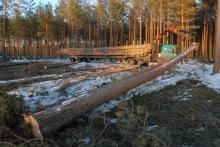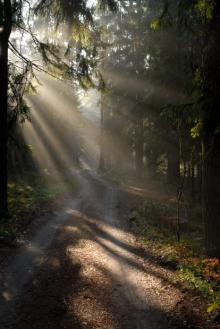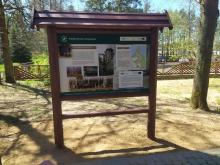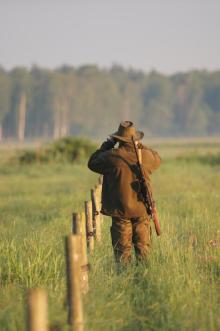 Asset Publisher
Asset Publisher
The State Forests National Forest Holding
The State Forests National Forest Holding is the largest organisation in the European Union managing forests, which belong to the State Treasury and celebrating its 90 anniversary this year.
Presently, we manage the area of one third of Poland's territory. Not long after the end of the Second World War, there was only 21 % of the area. Every year we plant 500 million of new trees, as we want Polish forests grow all the time.
Every year Polish foresters plant 500 million of trees.
85 % of nature reserves in Poland are located within the State Forests. 40 % of the forests managed by General Directorate of the State Forests are protected within the framework of European network Natura 2000. We fight against many threats: natural disasters, plaques of insects, trees' diseases, fires, pollutions, as well as poaching and vandalism.
We take care the forestry supplying the market with timber, as ecological and universal material, to be carried on in accordance with rules of balanced development (photography P.Fabjański).
One of our major tasks is making forests accessible to the society. We invite you to take advantage of these beautifully located within the forest wilderness holiday resorts, forester's lodges or guest rooms. That is for you, we create thousand kilometres of hiking trails, cycling paths or camping sites. All the above mentioned, you can find in service www.czaswlas.pl.
We also take care the forestry supplying the market with timber, as ecological and universal material, to be carried on in accordance with rules of balanced development. We obtain over 30 million of cubic meters of wood annually, twice as much as at the beginning of the nineties of the XX century.
Despite of this, the average of wood abundance per hectare of our forests is one fourth bigger than 20 years ago and 40% bigger than the average of European Union currently amounts.
In Poland in sectors connected with the forestry, there work about 375 thousand of people. It means that each 40 working Pole works in the forest.
In Poland in sectors connected with the forestry, there work about 375 thousand of people. It means that each 40 working Pole works in the forest. The sector of wood processing works out approximately 8 % of our GDP (Gross Domestic Product). Among others, thanks to the timber from the State Forests Poland is the 10 largest producer of furniture in the world, and the 4 largest furniture exporter.
The State Forests employ 25 thousand people. That way we are the 9 biggest employer in Poland. Among the largest companies in our country it takes 22 place in respect of its incomes and 11 place in respect of its profits. The value of assets, we manage, reaches 300 million zl. If we add social values, it will be worth one billion zlotych. We do not use money from the budget, but we earn money on our own to support the business. In spite of the financial crisis, since 2002, we continuously note down profits. Moreover, we pay taxes amounting 1,3 billion zl annually.
87 % of Poles think, the foresters are competent. We willingly share our knowledge of Polish forests, of their history and of nature values with the others. We publish books, periodicals, brochures; we also administer the website www.lasy.gov.pl . For children, the youth and teachers, we prepared internet service "E-lynx' Lynx Forest" (www.erys.pl). Our staff has supported schools in field of nature education for years. We also organise many actions to let people broaden their knowledge about forest, nature and ecology.
 Asset Publisher
Asset Publisher
Kolejni mieszkańcy zagrody adaptacyjnej dla żubrów
Kolejni mieszkańcy zagrody adaptacyjnej dla żubrów
 Fot. Marek Węgrzynowicz, Nadleśnictwo Augustów
Fot. Marek Węgrzynowicz, Nadleśnictwo Augustów
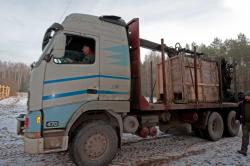 Fot. Marek Węgrzynowicz, Nadleśnictwo Augustów
Fot. Marek Węgrzynowicz, Nadleśnictwo Augustów
 Fot. Marek Węgrzynowicz, Nadleśnictwo Augustów
Fot. Marek Węgrzynowicz, Nadleśnictwo Augustów
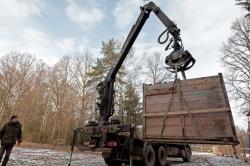 Fot. Marek Węgrzynowicz, Nadleśnictwo Augustów
Fot. Marek Węgrzynowicz, Nadleśnictwo Augustów
 Fot. Marek Węgrzynowicz, Nadleśnictwo Augustów
Fot. Marek Węgrzynowicz, Nadleśnictwo Augustów
 Fot. Marek Węgrzynowicz, Nadleśnictwo Augustów
Fot. Marek Węgrzynowicz, Nadleśnictwo Augustów
 Fot. Marek Węgrzynowicz, Nadleśnictwo Augustów
Fot. Marek Węgrzynowicz, Nadleśnictwo Augustów
 Fot. Marek Węgrzynowicz, Nadleśnictwo Augustów
Fot. Marek Węgrzynowicz, Nadleśnictwo Augustów
 Fot. Marek Węgrzynowicz, Nadleśnictwo Augustów
Fot. Marek Węgrzynowicz, Nadleśnictwo Augustów
 Fot. Marek Węgrzynowicz, Nadleśnictwo Augustów
Fot. Marek Węgrzynowicz, Nadleśnictwo Augustów
 Fot. Marek Węgrzynowicz, Nadleśnictwo Augustów
Fot. Marek Węgrzynowicz, Nadleśnictwo Augustów
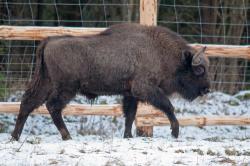 Fot. Marek Węgrzynowicz, Nadleśnictwo Augustów
Fot. Marek Węgrzynowicz, Nadleśnictwo Augustów
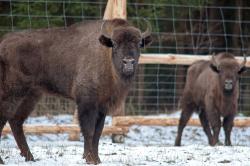 Fot. Marek Węgrzynowicz, Nadleśnictwo Augustów
Fot. Marek Węgrzynowicz, Nadleśnictwo Augustów
 Fot. Marek Węgrzynowicz, Nadleśnictwo Augustów
Fot. Marek Węgrzynowicz, Nadleśnictwo Augustów
13 lutego dwa kolejne żubry zostały przywiezione do zagrody adaptacyjnej na terenie Nadleśnictwa Augustów. Do wcześniej przywiezionej gromadki trafiła pięcioletnia krowa i dwuletni byczek.
Przywiezione osobniki stanowią tzw. grupę inicjalną, stanowiącą podstawę przyszłego stada. Skład grupy jest zależny od planowanego czasu przebywania żubrów w zagrodzie aklimatyzacyjnej. Nowo wsiedlane osobniki nie powinny być wypuszczane na wolność bezpośrednio po przywozie, gdyż na skutek stresu wywołanego transportem istnieje duże prawdopodobieństwo oddalania się ich od miejsc wypuszczenia na dużą odległość.
Oprócz podstawowego elementu opieki nad stadem wolnych żubrów, którym jest zapewnienie im wystarczającej ilości pokarmu (koszenie łąk, poletka zgryzowe, wodopoje) bardzo istotnym aspektem dla możliwości utrzymania żubrów w obrębie kompleksów leśnych, jest zapewnienie spokoju w ich ostojach. Obszary te powinny być wyraźnie oznakowane o bezwzględnym przestrzeganiu zakazu wstępu osób postronnych oraz prowadzenia prac leśnych.
Pomyślny rozwój populacji żubra w dużej mierze uzależniony jest od zdrowia poszczególnych osobników. Odłowione żubry zostały przebadane w kierunku gruźlicy bydła, enzootycznej białaczki bydła, i brucelozy bydła z wynikami ujemnymi. Badania przeprowadzono w PIWet-PIB Puławy. Żubry zostały również zbadane klinicznie i nie wykazywały objawów chorobowych mogących nasuwać podejrzenie choroby zakaźnej.
Odławianie żubrów może odbywać się za pomocą specjalnych urządzeń, tzw. odłowni lub klatek odłownych. Klatka odłowna powinna być ażurowa , zbudowana z drewnianych żerdzi i działać na zasadzie zapadni. Przy wyjściu takiej klatki znajduję się skrzynia transportowa, do której przemieszcza się żubra po odłowieniu. Innym sposobem jest zastosowanie indywidualnych boksów, gdzie podawana jest karma. Jeśli podczas odłowu żubry nie są niepokojone przez osoby postronne, bez problemu samodzielnie wchodzą do skrzyń transportowych. Żubry można przewozić transportem samochodowym, kolejowym i lotniczym. Transportowane są w pojedynczych skrzyniach odpowiadających wymiarom zwierząt. Podczas przewozu skrzynie ustawia się głową w kierunku jady lub bokiem, z możliwością dostępu obsłudze zarówno z przodu jak i z tyłu.
W czasie odłowu i transportu nie używa się uspokajających środków farmakologicznych.


 fot. Paweł Fabijański
fot. Paweł Fabijański
 fot. Paweł Fabijański
fot. Paweł Fabijański
 fot. Paweł Fabijański
fot. Paweł Fabijański

